University Research Proposal: Physical Activity and Mobility
VerifiedAdded on 2023/01/17
|7
|1343
|65
Project
AI Summary
This research proposal outlines a quantitative study using a randomized controlled trial to assess the effectiveness of a Physical Activity Facilitation (PAF) intervention on improving mobility and walking speed among older adults residing in aged care community centers in Melbourne. The study will involve participants aged 65 years and above, with mobility assessed using the Banner Mobility Assessment Tool (BMAT) and walking speed assessed using the 10-meter walk test before and after the intervention. Random sampling will be employed, and data analysis will involve t-tests to determine significant differences. The research aims to provide insights into the impact of PAF on mobility and walking speed, contributing to improved aged care services. The study acknowledges potential limitations such as a small sample size and the presence of age-related co-morbidities. References include key research papers and statistical resources.
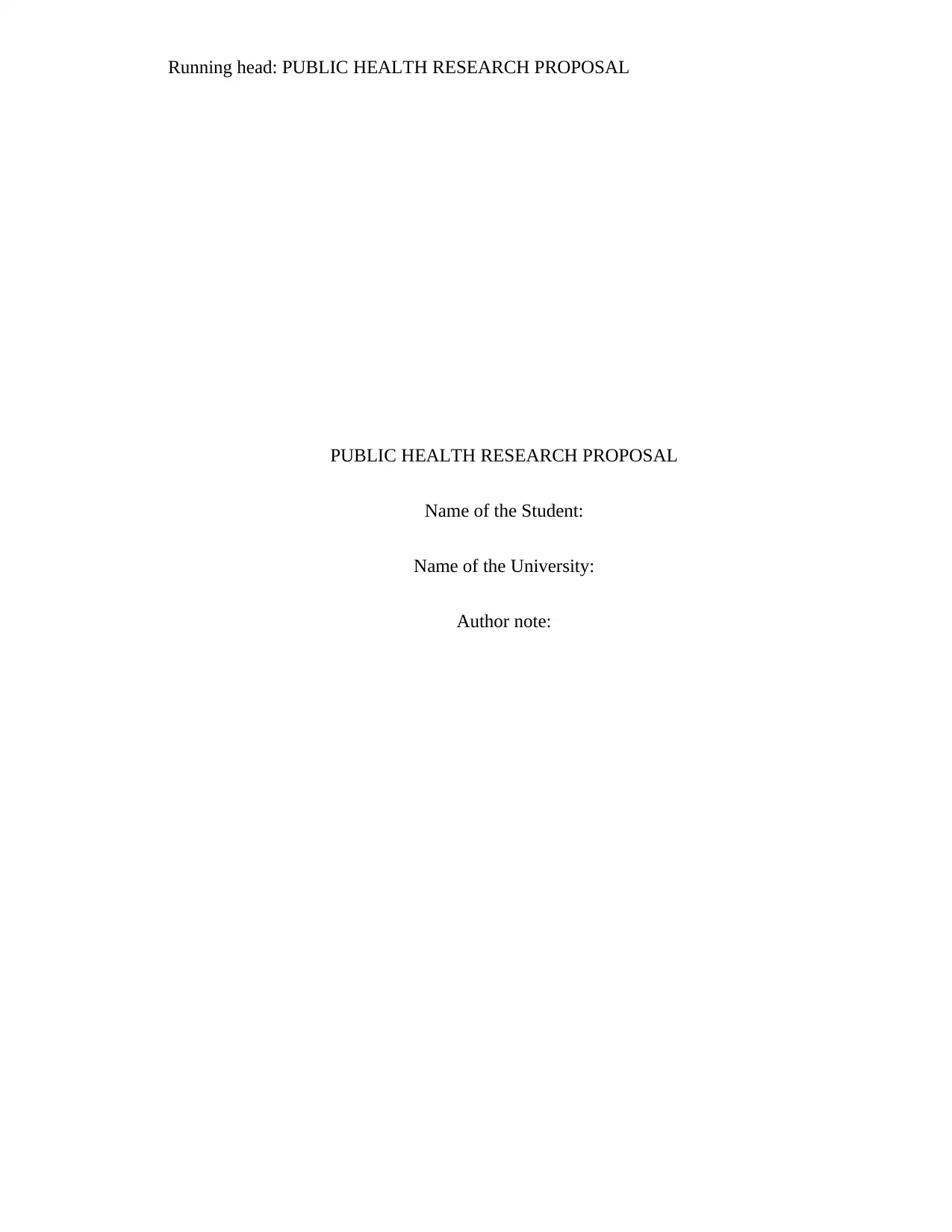
Running head: PUBLIC HEALTH RESEARCH PROPOSAL
PUBLIC HEALTH RESEARCH PROPOSAL
Name of the Student:
Name of the University:
Author note:
PUBLIC HEALTH RESEARCH PROPOSAL
Name of the Student:
Name of the University:
Author note:
Paraphrase This Document
Need a fresh take? Get an instant paraphrase of this document with our AI Paraphraser
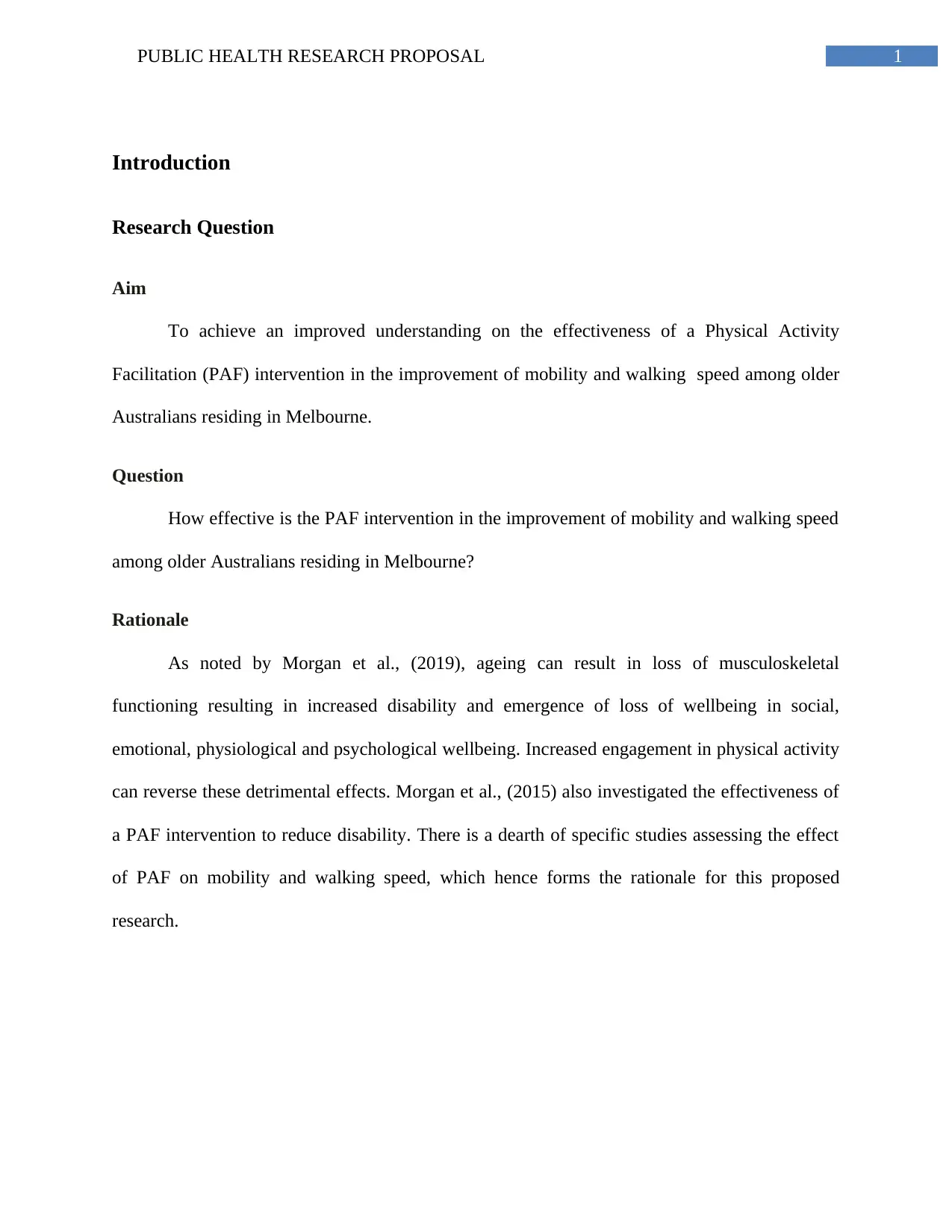
1PUBLIC HEALTH RESEARCH PROPOSAL
Introduction
Research Question
Aim
To achieve an improved understanding on the effectiveness of a Physical Activity
Facilitation (PAF) intervention in the improvement of mobility and walking speed among older
Australians residing in Melbourne.
Question
How effective is the PAF intervention in the improvement of mobility and walking speed
among older Australians residing in Melbourne?
Rationale
As noted by Morgan et al., (2019), ageing can result in loss of musculoskeletal
functioning resulting in increased disability and emergence of loss of wellbeing in social,
emotional, physiological and psychological wellbeing. Increased engagement in physical activity
can reverse these detrimental effects. Morgan et al., (2015) also investigated the effectiveness of
a PAF intervention to reduce disability. There is a dearth of specific studies assessing the effect
of PAF on mobility and walking speed, which hence forms the rationale for this proposed
research.
Introduction
Research Question
Aim
To achieve an improved understanding on the effectiveness of a Physical Activity
Facilitation (PAF) intervention in the improvement of mobility and walking speed among older
Australians residing in Melbourne.
Question
How effective is the PAF intervention in the improvement of mobility and walking speed
among older Australians residing in Melbourne?
Rationale
As noted by Morgan et al., (2019), ageing can result in loss of musculoskeletal
functioning resulting in increased disability and emergence of loss of wellbeing in social,
emotional, physiological and psychological wellbeing. Increased engagement in physical activity
can reverse these detrimental effects. Morgan et al., (2015) also investigated the effectiveness of
a PAF intervention to reduce disability. There is a dearth of specific studies assessing the effect
of PAF on mobility and walking speed, which hence forms the rationale for this proposed
research.
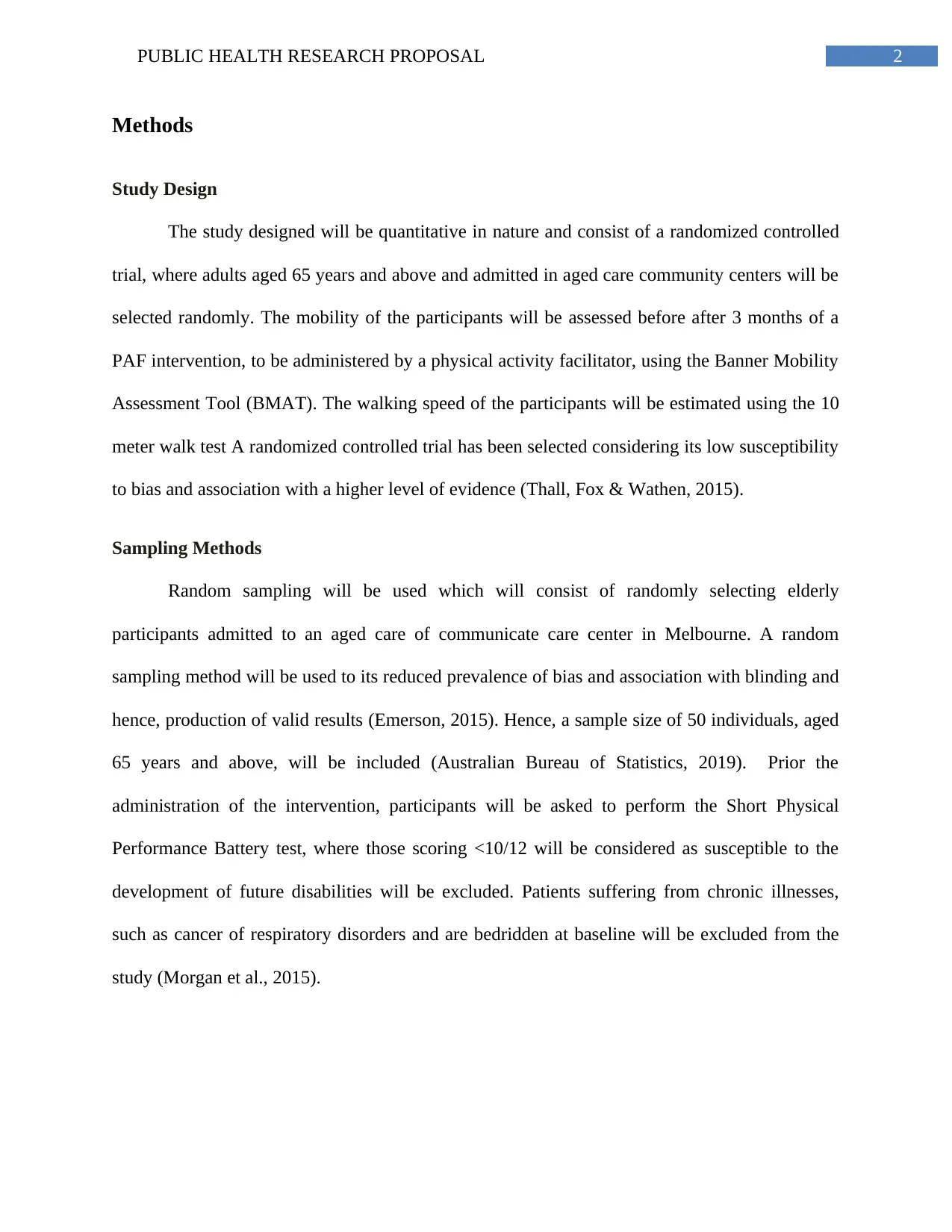
2PUBLIC HEALTH RESEARCH PROPOSAL
Methods
Study Design
The study designed will be quantitative in nature and consist of a randomized controlled
trial, where adults aged 65 years and above and admitted in aged care community centers will be
selected randomly. The mobility of the participants will be assessed before after 3 months of a
PAF intervention, to be administered by a physical activity facilitator, using the Banner Mobility
Assessment Tool (BMAT). The walking speed of the participants will be estimated using the 10
meter walk test A randomized controlled trial has been selected considering its low susceptibility
to bias and association with a higher level of evidence (Thall, Fox & Wathen, 2015).
Sampling Methods
Random sampling will be used which will consist of randomly selecting elderly
participants admitted to an aged care of communicate care center in Melbourne. A random
sampling method will be used to its reduced prevalence of bias and association with blinding and
hence, production of valid results (Emerson, 2015). Hence, a sample size of 50 individuals, aged
65 years and above, will be included (Australian Bureau of Statistics, 2019). Prior the
administration of the intervention, participants will be asked to perform the Short Physical
Performance Battery test, where those scoring <10/12 will be considered as susceptible to the
development of future disabilities will be excluded. Patients suffering from chronic illnesses,
such as cancer of respiratory disorders and are bedridden at baseline will be excluded from the
study (Morgan et al., 2015).
Methods
Study Design
The study designed will be quantitative in nature and consist of a randomized controlled
trial, where adults aged 65 years and above and admitted in aged care community centers will be
selected randomly. The mobility of the participants will be assessed before after 3 months of a
PAF intervention, to be administered by a physical activity facilitator, using the Banner Mobility
Assessment Tool (BMAT). The walking speed of the participants will be estimated using the 10
meter walk test A randomized controlled trial has been selected considering its low susceptibility
to bias and association with a higher level of evidence (Thall, Fox & Wathen, 2015).
Sampling Methods
Random sampling will be used which will consist of randomly selecting elderly
participants admitted to an aged care of communicate care center in Melbourne. A random
sampling method will be used to its reduced prevalence of bias and association with blinding and
hence, production of valid results (Emerson, 2015). Hence, a sample size of 50 individuals, aged
65 years and above, will be included (Australian Bureau of Statistics, 2019). Prior the
administration of the intervention, participants will be asked to perform the Short Physical
Performance Battery test, where those scoring <10/12 will be considered as susceptible to the
development of future disabilities will be excluded. Patients suffering from chronic illnesses,
such as cancer of respiratory disorders and are bedridden at baseline will be excluded from the
study (Morgan et al., 2015).
⊘ This is a preview!⊘
Do you want full access?
Subscribe today to unlock all pages.

Trusted by 1+ million students worldwide
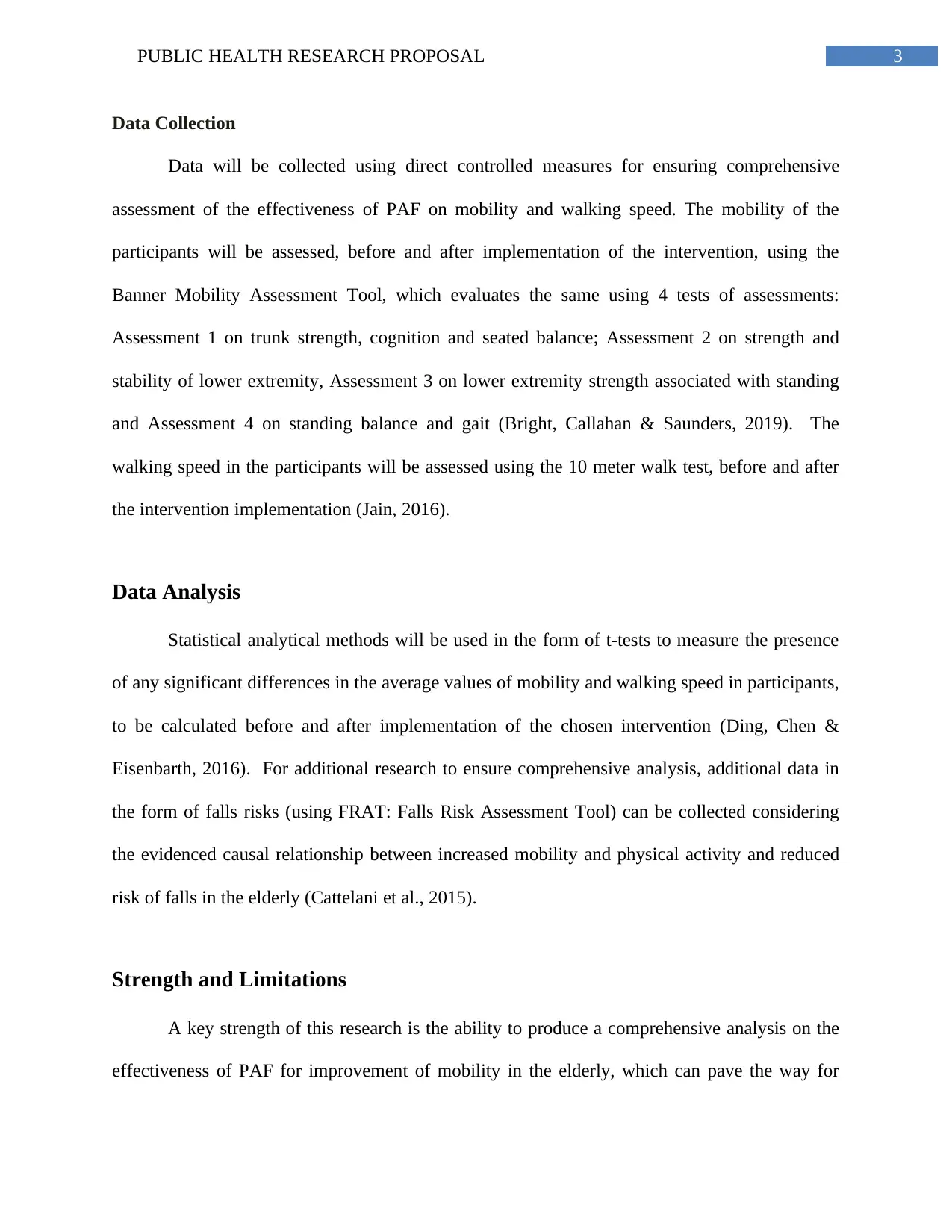
3PUBLIC HEALTH RESEARCH PROPOSAL
Data Collection
Data will be collected using direct controlled measures for ensuring comprehensive
assessment of the effectiveness of PAF on mobility and walking speed. The mobility of the
participants will be assessed, before and after implementation of the intervention, using the
Banner Mobility Assessment Tool, which evaluates the same using 4 tests of assessments:
Assessment 1 on trunk strength, cognition and seated balance; Assessment 2 on strength and
stability of lower extremity, Assessment 3 on lower extremity strength associated with standing
and Assessment 4 on standing balance and gait (Bright, Callahan & Saunders, 2019). The
walking speed in the participants will be assessed using the 10 meter walk test, before and after
the intervention implementation (Jain, 2016).
Data Analysis
Statistical analytical methods will be used in the form of t-tests to measure the presence
of any significant differences in the average values of mobility and walking speed in participants,
to be calculated before and after implementation of the chosen intervention (Ding, Chen &
Eisenbarth, 2016). For additional research to ensure comprehensive analysis, additional data in
the form of falls risks (using FRAT: Falls Risk Assessment Tool) can be collected considering
the evidenced causal relationship between increased mobility and physical activity and reduced
risk of falls in the elderly (Cattelani et al., 2015).
Strength and Limitations
A key strength of this research is the ability to produce a comprehensive analysis on the
effectiveness of PAF for improvement of mobility in the elderly, which can pave the way for
Data Collection
Data will be collected using direct controlled measures for ensuring comprehensive
assessment of the effectiveness of PAF on mobility and walking speed. The mobility of the
participants will be assessed, before and after implementation of the intervention, using the
Banner Mobility Assessment Tool, which evaluates the same using 4 tests of assessments:
Assessment 1 on trunk strength, cognition and seated balance; Assessment 2 on strength and
stability of lower extremity, Assessment 3 on lower extremity strength associated with standing
and Assessment 4 on standing balance and gait (Bright, Callahan & Saunders, 2019). The
walking speed in the participants will be assessed using the 10 meter walk test, before and after
the intervention implementation (Jain, 2016).
Data Analysis
Statistical analytical methods will be used in the form of t-tests to measure the presence
of any significant differences in the average values of mobility and walking speed in participants,
to be calculated before and after implementation of the chosen intervention (Ding, Chen &
Eisenbarth, 2016). For additional research to ensure comprehensive analysis, additional data in
the form of falls risks (using FRAT: Falls Risk Assessment Tool) can be collected considering
the evidenced causal relationship between increased mobility and physical activity and reduced
risk of falls in the elderly (Cattelani et al., 2015).
Strength and Limitations
A key strength of this research is the ability to produce a comprehensive analysis on the
effectiveness of PAF for improvement of mobility in the elderly, which can pave the way for
Paraphrase This Document
Need a fresh take? Get an instant paraphrase of this document with our AI Paraphraser

4PUBLIC HEALTH RESEARCH PROPOSAL
improved aged care services and assessments in the future. However, the small sample size may
be a limitation in terms of possibilities of data skewing and type II statistical error (Matuschek et
al., 2017). Additional, prevalence of age associated co-morbidities may be considered as a
limitation in terms of confounding variables (Teschke & Danan, 2018).
improved aged care services and assessments in the future. However, the small sample size may
be a limitation in terms of possibilities of data skewing and type II statistical error (Matuschek et
al., 2017). Additional, prevalence of age associated co-morbidities may be considered as a
limitation in terms of confounding variables (Teschke & Danan, 2018).
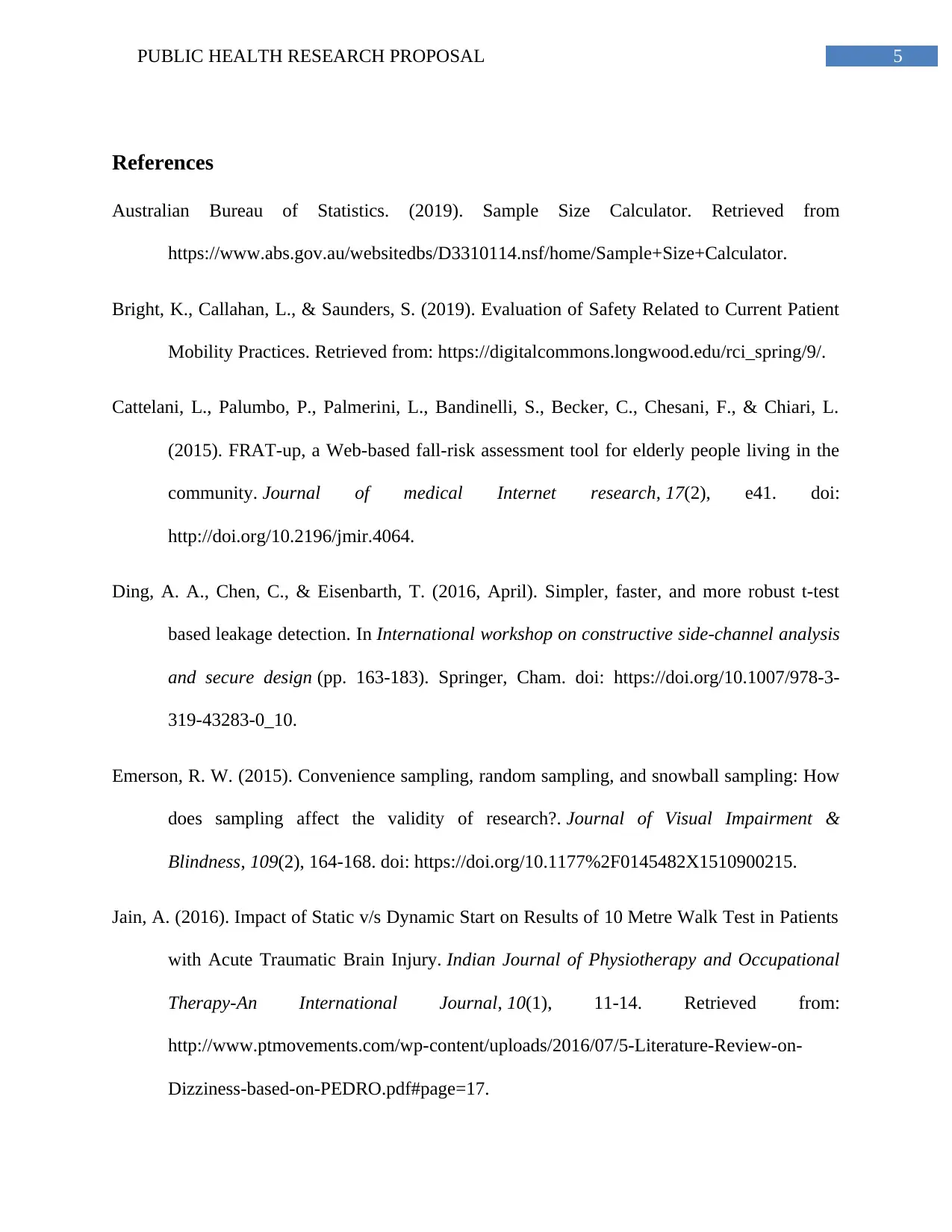
5PUBLIC HEALTH RESEARCH PROPOSAL
References
Australian Bureau of Statistics. (2019). Sample Size Calculator. Retrieved from
https://www.abs.gov.au/websitedbs/D3310114.nsf/home/Sample+Size+Calculator.
Bright, K., Callahan, L., & Saunders, S. (2019). Evaluation of Safety Related to Current Patient
Mobility Practices. Retrieved from: https://digitalcommons.longwood.edu/rci_spring/9/.
Cattelani, L., Palumbo, P., Palmerini, L., Bandinelli, S., Becker, C., Chesani, F., & Chiari, L.
(2015). FRAT-up, a Web-based fall-risk assessment tool for elderly people living in the
community. Journal of medical Internet research, 17(2), e41. doi:
http://doi.org/10.2196/jmir.4064.
Ding, A. A., Chen, C., & Eisenbarth, T. (2016, April). Simpler, faster, and more robust t-test
based leakage detection. In International workshop on constructive side-channel analysis
and secure design (pp. 163-183). Springer, Cham. doi: https://doi.org/10.1007/978-3-
319-43283-0_10.
Emerson, R. W. (2015). Convenience sampling, random sampling, and snowball sampling: How
does sampling affect the validity of research?. Journal of Visual Impairment &
Blindness, 109(2), 164-168. doi: https://doi.org/10.1177%2F0145482X1510900215.
Jain, A. (2016). Impact of Static v/s Dynamic Start on Results of 10 Metre Walk Test in Patients
with Acute Traumatic Brain Injury. Indian Journal of Physiotherapy and Occupational
Therapy-An International Journal, 10(1), 11-14. Retrieved from:
http://www.ptmovements.com/wp-content/uploads/2016/07/5-Literature-Review-on-
Dizziness-based-on-PEDRO.pdf#page=17.
References
Australian Bureau of Statistics. (2019). Sample Size Calculator. Retrieved from
https://www.abs.gov.au/websitedbs/D3310114.nsf/home/Sample+Size+Calculator.
Bright, K., Callahan, L., & Saunders, S. (2019). Evaluation of Safety Related to Current Patient
Mobility Practices. Retrieved from: https://digitalcommons.longwood.edu/rci_spring/9/.
Cattelani, L., Palumbo, P., Palmerini, L., Bandinelli, S., Becker, C., Chesani, F., & Chiari, L.
(2015). FRAT-up, a Web-based fall-risk assessment tool for elderly people living in the
community. Journal of medical Internet research, 17(2), e41. doi:
http://doi.org/10.2196/jmir.4064.
Ding, A. A., Chen, C., & Eisenbarth, T. (2016, April). Simpler, faster, and more robust t-test
based leakage detection. In International workshop on constructive side-channel analysis
and secure design (pp. 163-183). Springer, Cham. doi: https://doi.org/10.1007/978-3-
319-43283-0_10.
Emerson, R. W. (2015). Convenience sampling, random sampling, and snowball sampling: How
does sampling affect the validity of research?. Journal of Visual Impairment &
Blindness, 109(2), 164-168. doi: https://doi.org/10.1177%2F0145482X1510900215.
Jain, A. (2016). Impact of Static v/s Dynamic Start on Results of 10 Metre Walk Test in Patients
with Acute Traumatic Brain Injury. Indian Journal of Physiotherapy and Occupational
Therapy-An International Journal, 10(1), 11-14. Retrieved from:
http://www.ptmovements.com/wp-content/uploads/2016/07/5-Literature-Review-on-
Dizziness-based-on-PEDRO.pdf#page=17.
⊘ This is a preview!⊘
Do you want full access?
Subscribe today to unlock all pages.

Trusted by 1+ million students worldwide
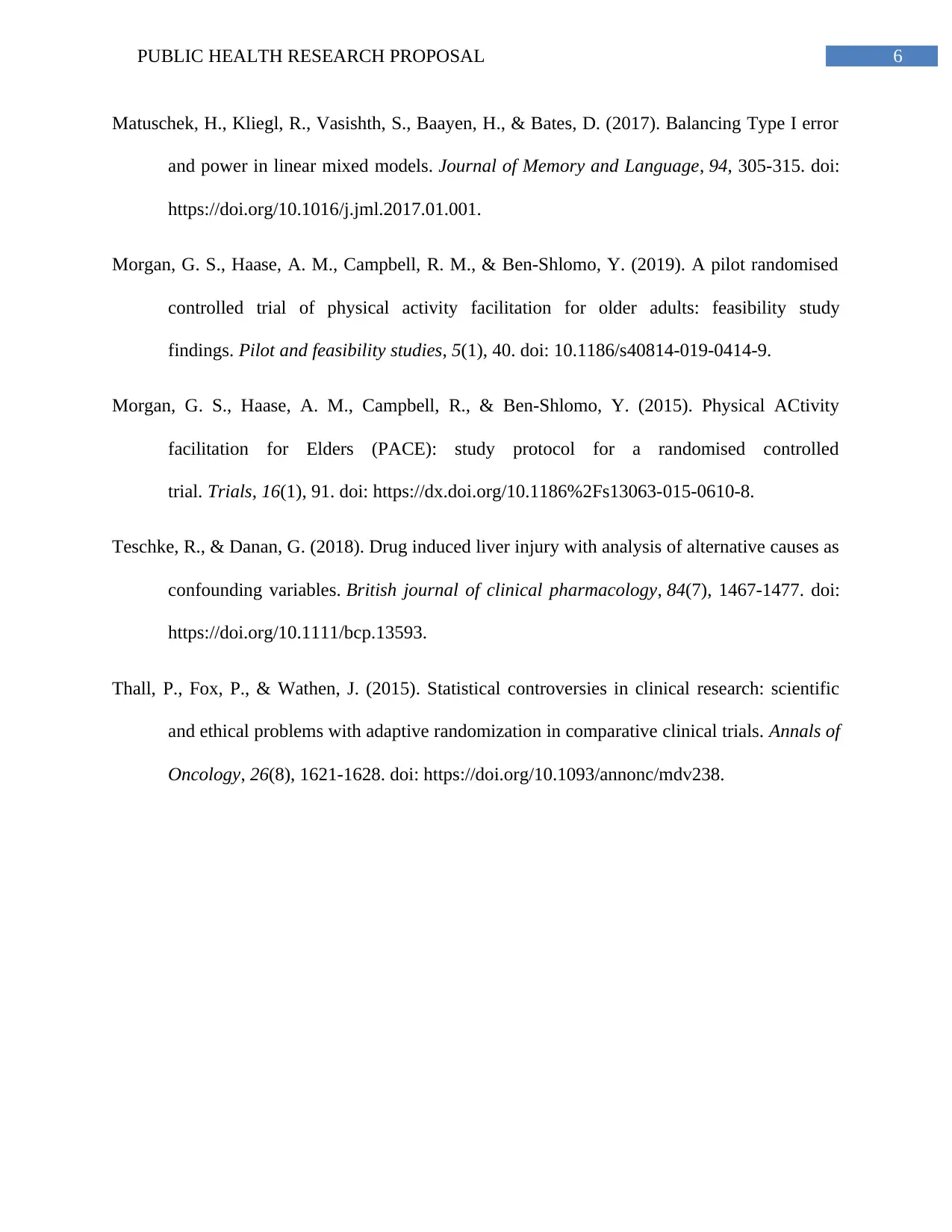
6PUBLIC HEALTH RESEARCH PROPOSAL
Matuschek, H., Kliegl, R., Vasishth, S., Baayen, H., & Bates, D. (2017). Balancing Type I error
and power in linear mixed models. Journal of Memory and Language, 94, 305-315. doi:
https://doi.org/10.1016/j.jml.2017.01.001.
Morgan, G. S., Haase, A. M., Campbell, R. M., & Ben-Shlomo, Y. (2019). A pilot randomised
controlled trial of physical activity facilitation for older adults: feasibility study
findings. Pilot and feasibility studies, 5(1), 40. doi: 10.1186/s40814-019-0414-9.
Morgan, G. S., Haase, A. M., Campbell, R., & Ben-Shlomo, Y. (2015). Physical ACtivity
facilitation for Elders (PACE): study protocol for a randomised controlled
trial. Trials, 16(1), 91. doi: https://dx.doi.org/10.1186%2Fs13063-015-0610-8.
Teschke, R., & Danan, G. (2018). Drug induced liver injury with analysis of alternative causes as
confounding variables. British journal of clinical pharmacology, 84(7), 1467-1477. doi:
https://doi.org/10.1111/bcp.13593.
Thall, P., Fox, P., & Wathen, J. (2015). Statistical controversies in clinical research: scientific
and ethical problems with adaptive randomization in comparative clinical trials. Annals of
Oncology, 26(8), 1621-1628. doi: https://doi.org/10.1093/annonc/mdv238.
Matuschek, H., Kliegl, R., Vasishth, S., Baayen, H., & Bates, D. (2017). Balancing Type I error
and power in linear mixed models. Journal of Memory and Language, 94, 305-315. doi:
https://doi.org/10.1016/j.jml.2017.01.001.
Morgan, G. S., Haase, A. M., Campbell, R. M., & Ben-Shlomo, Y. (2019). A pilot randomised
controlled trial of physical activity facilitation for older adults: feasibility study
findings. Pilot and feasibility studies, 5(1), 40. doi: 10.1186/s40814-019-0414-9.
Morgan, G. S., Haase, A. M., Campbell, R., & Ben-Shlomo, Y. (2015). Physical ACtivity
facilitation for Elders (PACE): study protocol for a randomised controlled
trial. Trials, 16(1), 91. doi: https://dx.doi.org/10.1186%2Fs13063-015-0610-8.
Teschke, R., & Danan, G. (2018). Drug induced liver injury with analysis of alternative causes as
confounding variables. British journal of clinical pharmacology, 84(7), 1467-1477. doi:
https://doi.org/10.1111/bcp.13593.
Thall, P., Fox, P., & Wathen, J. (2015). Statistical controversies in clinical research: scientific
and ethical problems with adaptive randomization in comparative clinical trials. Annals of
Oncology, 26(8), 1621-1628. doi: https://doi.org/10.1093/annonc/mdv238.
1 out of 7
Your All-in-One AI-Powered Toolkit for Academic Success.
+13062052269
info@desklib.com
Available 24*7 on WhatsApp / Email
![[object Object]](/_next/static/media/star-bottom.7253800d.svg)
Unlock your academic potential
Copyright © 2020–2025 A2Z Services. All Rights Reserved. Developed and managed by ZUCOL.